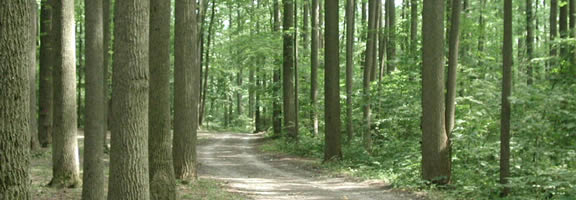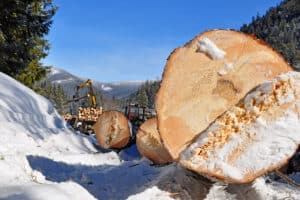Most — but not all — timberland investments require little routine maintenance. But one upkeep job that I recommend is for the landowner to maintain existing roads in usable condition.
The reasons to provide continuing road access within a timber tract include:
- Fire suppression;
- Safety—evacuation in case of accident;
- Recreational uses—hiking, horseback riding, ATVing, snowmobiling, etc.;
- Firewood gathering for personal use or sale, which can be combined with a Timber Stand Improvement cutting of culls;
- Hunting/fishing;
- Easier control of invasive/unwanted species, such as multiflora rose;
- DIY logging, e.g., for woodworking projects; and
- Commercial uses, such as logging and mineral development.
Assuming your tract has something of a network of old skid roads, the most basic maintenance requires one or two road mowings each year to control vegetation; pruning of branches that are growing into the roadway; and removing rocks and fallen limbs.
If mowing is not done, brambles and trees will reclaim the road, making it impassable. If intrusive branches are not clipped, they will take their toll on passersby, especially new full-size pickups and those on horseback. If rocks and limbs are not pitched aside, they will treat your undercarriage unkindly and expensively.
Occasionally, you might find it necessary to throw dirt over a rough, rocky spot, or place stone in a perennial wet spot.
And every so often, you should have a bulldozer come through and re-excavate the erosion-control dips (that run diagonally on uphill roads) so that they continue to carry water off to the side. If a road on an incline does not have dips, water will cut a channel straight down the roadway and cause erosion issues of various sorts.
Dips are shallow, gentle-sided trenches that allow vehicle traffic to pass.
Some states require that loggers leave logging jobs with erosion control achieved through the installation of water bars. Water bars are deep, vertical-sided trenches that cannot be navigated with vehicles (unless the water bars are bridged or filled in). They are more effective than dips in keeping erosion under control, but they render the property inaccessible to vehicles. For that reason, I’ve turned water bars into dips after loggers have left.
Mowing requires a tractor with a brushhog attachment—a rear-mounted mower with a heavy-duty blade. The attachment has to be correctly sized to the tractor. This type of job is easily hired in from a neighbor if you’re not close by.
Absentee timberland owners can also benefit by making an arrangement with a local person that trades road maintenance in return for the right to cut a small amount of firewood each year. The firewood cutter will keep roads clear and usable, because he does not want to tear up his truck running over your rocks.
I advise the absentee timberland owner to hire a consulting forester to paint stump and butt those trees that the firewood cutter is allowed to harvest each year. That method guides the logger to the permitted trees and provides a record that he cut only the painted trees. If you find a stump without a paint dot on it, the firewood cutter has cut a tree that should not have been. The consulting forester will mark out those trees whose removal will benefit the remaining higher-value stems.
This type of arrangement can be abused, but my experience is that the local firewood cutter will look after the absentee’s property with great care. It’s a good deal from his point of view, particularly if he gets to do some hunting on it as well.
A timber tract with adequately maintained roads is a lot more fun, safer and functional than one whose roads are neglected. If you like doing this work, it’s just one more Saturday chore three or four days a year. If you don’t like this work, it’s easy to find someone to do it for you.
And a final thought. Timberland with usable roads is — and should be — priced higher than tracts without. And timber buyers will discount their stumpage offers on a tract where the logger must build a lot of road from scratch. (Make sure to include a clause in a timber-sale contract that requires the logger to leave your roads in as good or better condition than when he started, and free of logging slash and debris.)
Woods roads have been a great pleasure for me.
This content may not be used or reproduced in any manner whatsoever, in part or in whole, without written permission of LANDTHINK. Use of this content without permission is a violation of federal copyright law. The articles, posts, comments, opinions and information provided by LANDTHINK are for informational and research purposes only and DOES NOT substitute or coincide with the advice of an attorney, accountant, real estate broker or any other licensed real estate professional. LANDTHINK strongly advises visitors and readers to seek their own professional guidance and advice related to buying, investing in or selling real estate.










Very informative article. Thanks.
This is great info for anyone involved with land – owners, buyers, sellers, agents, etc.
Great job!
Thanks Curtis…. wise words as always.
Note to new landowners: The USDA has their EQIP program for funding some of this type of activity, if you are doing some conservation related activities/practices on your land. Items such as mowing and putting in culverts are covered I believe – the idea is that by assisting with the cost of this work, the Feds are encouraging more conservation/wildlife habitat enhancement. If you think about it, grassy logging roads are like ribbons of meadow running through the woods and bring in all kinds of insects/birds/critters, so it’s worthwhile for that reason, too. Of course there are numerous other sources of funding for conservation, but that’s a whole other article! 🙂
Very nice article. I spend alot of time on logging roads and can’t tell you how nice it is to show and sell a tract of timber that has good roads.
One thing I’ve also found useful is that if you buy a tract of land to timber with out good roads, you can work with the timber crew to have your roads built where everyone can benifit from them.